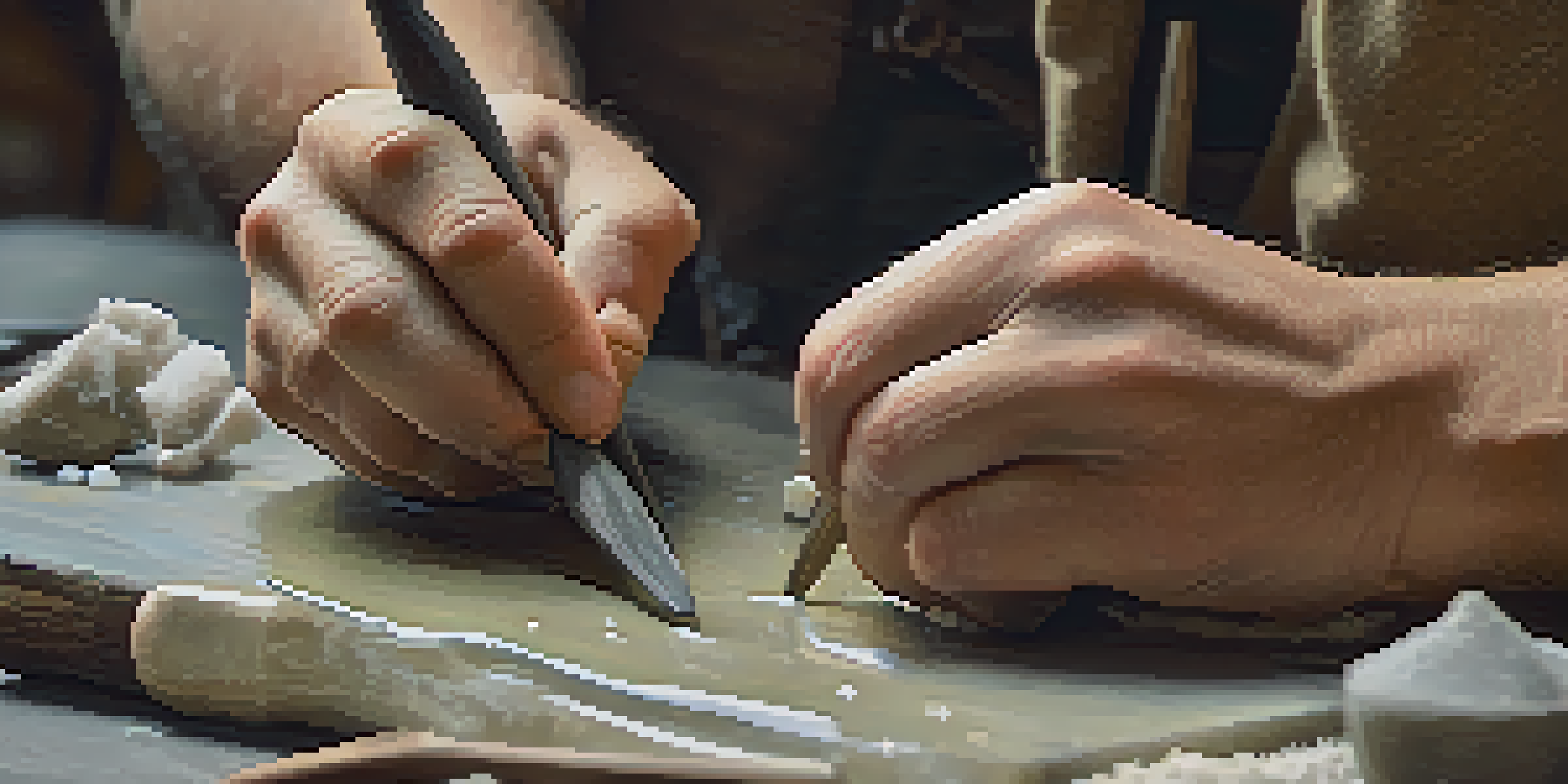The Art of Stone Carving: Techniques for Beginners

Understanding the Basics of Stone Carving Tools
Before diving into stone carving, it's crucial to familiarize yourself with the essential tools. Chisels, hammers, and rasps are your best friends in this craft. Each tool has a specific purpose; for instance, chisels come in various shapes for different carving techniques.
Every artist was first an amateur.
A common starting point is the point chisel, which helps break up large pieces of stone. Meanwhile, flat chisels are ideal for smoothing surfaces, giving your piece a refined look. Investing in good-quality tools not only enhances your work but also makes the process more enjoyable.
Don’t forget to prioritize safety! Protective eyewear and gloves are a must when working with stone. Understanding your tools and how to use them safely will set a solid foundation for your carving journey.
Choosing the Right Stone for Your Projects
Selecting the right stone is as important as mastering the techniques. Beginners often start with softer stones like soapstone or alabaster since they are easier to carve. These materials allow for more experimentation as you hone your skills.

As you gain confidence, you might want to try your hand at harder stones like marble or granite. Each type of stone has its own unique characteristics, affecting the final look of your piece. For instance, marble has a beautiful veining that can add depth to your work.
Essential Tools for Stone Carving
Familiarizing yourself with chisels, hammers, and rasps is crucial for a successful stone carving journey.
Ultimately, your choice of stone should reflect your artistic vision. Take your time to explore different options and see which one resonates with you. Remember, the right stone can inspire creativity and lead to stunning results.
Basic Carving Techniques Every Beginner Should Know
As a beginner, mastering a few basic techniques will make all the difference in your carving journey. Start with the roughing technique, where you remove large chunks of stone to shape your piece. This stage is all about getting the general form before refining the details.
Art is the most beautiful of all lies.
Next, practice the smoothing technique, which involves using a rasp or sandpaper to create a polished finish. This step can transform your rough piece into a stunning work of art. Don’t rush this process; a good finish often requires patience and attention to detail.
Lastly, consider learning about relief carving. This technique allows you to create depth and dimension in your work, making your piece truly stand out. By combining these basic techniques, you’ll lay a solid foundation for more advanced carving in the future.
Developing Your Artistic Vision and Style
Every artist has a unique perspective, and developing your artistic vision is key in stone carving. Spend time sketching ideas or observing the natural forms in stone. This can help you determine the direction of your projects and inspire your creativity.
Consider exploring various styles, from abstract to realistic, to find what resonates with you. Engaging with other artists, whether through local workshops or online communities, can provide valuable insights and help you refine your style.
Choosing the Right Stone Matters
Selecting the appropriate stone type, from softer materials for beginners to harder ones for advanced work, greatly influences your artistic outcomes.
Remember, your artistic journey is personal. Embrace mistakes and learn from them; they often lead to unexpected discoveries and growth. Cultivating your artistic voice will not only enhance your work but also make the process more fulfilling.
The Importance of Practice in Stone Carving
Like any skill, practice is essential in stone carving. Set aside regular time to work on your projects, even if it’s just a couple of hours a week. Consistency will help you build muscle memory and improve your technique over time.
Don’t be afraid to experiment with different techniques and styles. The more you carve, the more you’ll discover what works best for you, and your confidence will grow. Each piece you create, regardless of the outcome, will teach you something new.
Lastly, keep a journal of your work. Documenting your progress not only helps track improvements but also serves as a source of inspiration. Reflecting on your journey can motivate you to keep pushing your boundaries and exploring new possibilities.
Finding Inspiration from Nature and Art
Inspiration can be found all around you, especially in nature. Take walks in parks or visit natural formations to observe shapes and textures that spark your creativity. Nature can teach you about balance, harmony, and the beauty of imperfection.
Additionally, studying the works of renowned stone carvers can offer valuable insights into techniques and styles. Books, documentaries, or even museum visits can broaden your understanding and appreciation of the art form.
Practice Fuels Your Artistic Growth
Regular practice and experimentation are key to improving your stone carving skills and developing your unique style.
Don’t forget to seek inspiration from everyday life. Even small objects or experiences can ignite new ideas for your carving projects. Keep an open mind, and let your surroundings fuel your creativity.
Joining a Community of Stone Carving Enthusiasts
Joining a community of fellow stone carving enthusiasts can significantly enhance your learning experience. Look for local classes, workshops, or online forums where you can connect with other artists. Sharing tips and techniques can accelerate your growth and keep you motivated.
Participating in group projects or exhibitions can also provide exposure and feedback on your work. Engaging with others allows you to appreciate diverse styles and approaches, which can inspire your own creations.

Ultimately, being part of a community fosters a sense of belonging and support. Surrounding yourself with like-minded individuals can make your stone carving journey more enjoyable and enriching.